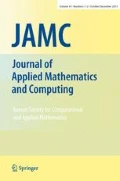Abstract
Enumeration of the primes with difference 4 between consecutive primes, is counted up to 5×1010, yielding the counting function π2,4(5 × 1010) = 118905303. The sum of reciprocals of primes with gap 4 between consecutive primes is computedB 4(5×1010)=1.197054473029 andB 4=1.197054±7×10−6. And Enumeration of the primes with difference 6 between consecutive primes, is counted up to 5×1010, yielding the counting function π2,6(5 × 1010) = 215868063. The sum of reciprocals of primes with gap 6 between consecutive primes is computedB 6(5×1010)=0.93087506039231 andB 6=1.135835±1.2×10−6.
Similar content being viewed by others
References
G.H. Hardy and J.E. LittlewoodSome problems of “Partitio Numerrorum”, III: On the expression of a number as a sum of primes, Acta Math., v.44 (1923), 1–70. Reprinted in Collected papers of G.H. Hardy, Clarendon Press, Oxford, vol. 3 (1966), 561–630
R.J. Harleyunpablished work, accessed (December 2000) at http://pauillac.inria. fr/∼ harley/wnt.html
P. Sebah and X. GourdonIntroduction to twin primes and Brun's constant computation, See http://numbers.computation.free.fr/constant/constant.html (2002).
H. Halberstam and H.E. RichertSieve Methods, Academic Press (New York) (1974).
R. Crandall and C. PomerancePrime numbers, Springer-Verlag (New York) (2001), 12–14.
T. NicelyEnumeration to 10 14 of the Twin primes and Brun's constant, Virginia J. Sci., v. 46 (1996), 195–204. Enumeration to 1.6×1015 of the twin primes and Brun's constant accessed (1999–2002) at http://www.trnicely.net/twins/twins2.html.
M. WolfOn the Twin and Cousin primes, See http://www.ift.uni.wroc.pl/∼mwolf/(1996)
D.X. CharlesSieve Method, See http://www.cs.wisc.edu/∼cdx/seive.pdf
P. GiblinPrimes And Programming, Cambridge University Press (1993), 49.
H. RieselPrime Numbers and Computer Methods for Factorization, 2nd ed. Progress in Mathematics, vol. 126 (yr1994), 255.
Author information
Authors and Affiliations
Corresponding author
Additional information
Yeonyong Park received his Ph. D at KAIST under the direction of Hong Oh Kim. Since 1992 he has been at the Mokpo National University as a faculty. His research interests focus on the theory of harmonic analysis and the computation of gaps of the prime number.
Heonsoo Lee received his Ph.D at Mokpo national university under the direction of Yeonyong Park. Since 2003 he has been at the Mokpo National University as a lecturer. His research interests focus on the theory of the computation of gaps of the prime number.
Rights and permissions
About this article
Cite this article
Park, Y., Lee, H. On the several differences between primes. JAMC 13, 37–51 (2003). https://doi.org/10.1007/BF02936073
Received:
Issue Date:
DOI: https://doi.org/10.1007/BF02936073




